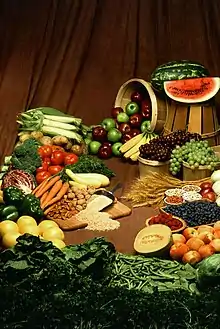Natural food
Natural food and all-natural food are widely used terms in food labeling and marketing with a variety of definitions, often to imply foods that are not ultra-processed. In some countries like the United Kingdom, the term "natural" is defined and enforced;[2] in others, such as the United States, it is not enforced although there is for example USDA enforcement of organic labelling.[3]

The term is assumed to describe foods whose ingredients are natural products (in the chemist's sense of that term),[4] and it has been noted as conveying an appeal to nature.[5][6][7][8][9]
Diverse definitions
While almost all foodstuffs are derived from the natural products of plants and animals,[10] “natural foods” are often assumed to be foods that are not processed, or do not contain any food additives, or do not contain particular additives such as hormones, antibiotics, sweeteners, food colors, preservatives, or flavorings that were not originally in the food.[11] In fact, many people (63%) when surveyed showed a preference for products labeled "natural" compared to the unmarked counterparts, based on the common belief (86% of polled consumers) that the term "natural" indicated that the food does not contain any artificial ingredients.[12]
The term is variously misused on labels and in advertisements.[13] The international Food and Agriculture Organization’s Codex Alimentarius does not recognize the term “natural” but does have a standard for organic foods.[14]
Definition by process and by product
United Kingdom
In the United Kingdom, the Food Standards Agency has published criteria for the use of several terms in food labeling. The guidance, in general, restricts the use of natural to foods that have "ingredients produced by nature, not the work of man or interfered with by man." Natural flavorings are explicitly defined by separate laws.[2]
There are different standards for various types of food, such as dairy products. It also gives standards for some food processing techniques, such as fermentation or pasteurization. The standard explicitly rules out "foods derived from novel processes, GM or cloning."[15]
Definition by process only
Canada
The Canadian Food Inspection Agency restricts the use of "natural" to foods that have not been significantly altered by processing and gives examples of processes that do or do not significantly alter food. This includes two specific additional requirements:[16]
- A natural food or ingredient of a food is not expected to contain, or to ever have contained, an added vitamin, mineral nutrient, artificial flavoring agent or food additive.
- A natural food or ingredient of a food does not have any constituent or fraction thereof removed or significantly changed, except the removal of water.
Israel
In Israel, natural ingredients are defined as part of the Labelling of Prepacked Food Standard (Israeli Standard SI 1145, which is legally binding).
The standard offers a list of 33 processes which are allowed in natural ingredients, all of which are physical treatments and not chemical modifications. These include blending, cleaning, extrusion, freezing, drying, etc.
A specific ingredient can be called "natural" if it didn't go through any processing except for the listed ones. The whole food can be called "natural" if the food is not a blend of foods (even if they are all-natural), has no added ingredients, and underwent only the specified processes.[17]
Lack of definition
United States

In the United States, there are laws/regulations and agencies to protect the consumer when purchasing food products, specifically dedicated to the packaging and labeling. Some laws and organizations include the Nutrition and Labeling Education Act, the Federal Food, Drug, and Cosmetic Act, and the Food Safety and Inspection Service (FSIS).
FSIS is a subsection of the United States Department of Agriculture (USDA), which is tasked with the responsibility of "ensuring that the nation's commercial supply of meat, poultry, and egg products is safe, wholesome, and correctly labeled and packaged."[18] The USDA partnered with the Food and Drug Administration (FDA) to develop and issue regulations against the inappropriate usage of "natural" labels; yet, the FDA does not have specific rules for “natural" labeling. It advised on their website "the agency has not objected to the use of the term if the food does not contain added color, artificial flavors, or synthetic substances."[19]
Furthermore, the FDA has not developed any rules or regulations on the defining features of what qualifies a product as "natural." The FDA does reference a definition of "natural" in their informal policy (Ref. 53) that defines "natural" as "nothing artificial or synthetic (including colors regardless of source) is included in, or has been added to, the product that would not normally be expected to be there."[20]
The Food, Drug, and Cosmetic Act prohibits labeling that is false or misleading. The USDA has a standard for organic food called the National Organic Program.[3] As of August 2005, the USDA had a section governing "natural claims" in its Food Standards and Labeling Policy Book;[21][22] the USDA's regulatory jurisdiction applies only to meat, poultry, and egg products.
Because few regulations are governing the labeling of "natural" foods, manufacturers can include ingredients that may not be considered natural by some consumers.
The poultry industry has been criticized by the Center for Science in the Public Interest for labeling chicken meat "all-natural" after it has been injected with saline solution up to 25% of its weight. There is no legal recourse to prevent this labeling.[23]
Although there are few legal U.S. definitions for natural foods, there are unofficial or informal definitions, none of which are applied uniformly to foods labeled "natural".
References
- "UK | Seaweed allows Smarties comeback". BBC News. 2008-02-11. Retrieved 2009-07-22.
- "Criteria for use of the terms Fresh, Pure, Natural Etc. in food labeling" (PDF). Food Standards Agency.
- "National Organic Program". AMS.
- "About Us". Natural Products Foundation. Retrieved 2013-12-07.
Natural products are represented by a wide array of consumer goods that continue to grow in popularity each year. These products include natural and organic foods, dietary supplements, pet foods, health and beauty products, "green" cleaning supplies and more. Generally, natural products are considered those formulated without artificial ingredients and that are minimally processed.
- Meier, Brian P.; Dillard, Amanda J.; Lappas, Courtney M. (2019). "Naturally better? A review of the natural-is-better bias". Social and Personality Psychology Compass. 13 (8): e12494. doi:10.1111/spc3.12494. ISSN 1751-9004.
- Singer, Peter (2011). Practical Ethics (3rd ed.). Cambridge University Press. pp. 60–61. ISBN 978-0521707688.
There would still be an error of reasoning in the assumption that because this process is natural it is right.
- Edward Moore, George (1922). Principia Ethica. Cambridge: Cambridge University Press. p. 45.
- "The current scientific view of living things is that they are machines whose components are biochemicals." Rodney Brooks, "The relationship between matter and life", Nature 409 (2010), p. 410.
- Baggini, Julian (2004). Making Sense: Philosophy Behind the Headlines. Oxford University Press. pp. 181–182. ISBN 978-0-19-280506-5.
- Food processing: a century of change, R. W. Welch and P. C. Mitchell (2000) British Medical Bulletin, 56 (No 1) 1-17, http://bmb.oxfordjournals.org/cgi/reprint/56/1/1-a.pdf%5B%5D
- Ikerd, John. The New American Food Economy.
- Weaver, A. (2014). "Natural" Foods: Inherently Confusing. Journal of Corporation Law, 39(3), 657-674. http://connection.ebscohost.com/c/articles/99055404/natural-foods-inherently-confusing
- "Guide to Food Labeling and Advertising, Chapter 4". Canadian Food Inspection Agency.
- "List of standards". Food and Agriculture Organization.
- "Criteria for use of the terms Fresh, Pure, Natural Etc. in food labeling" (PDF). Food Standards Agency. p. 16.
- "Guide to Food Labeling and Advertising, Chapter 4". Canadian Food Inspection Agency.
- "Food and Agricultural Import Regulations and Standards" (PDF). US Department of Agriculture.
- Weaver, A. (2014). "Natural" Foods: Inherently Confusing. Journal of Corporation Law, 39(3), 657-674. http://connection.ebscohost.com/c/articles/99055404/natural-foods-inherently-confusing
- FDA Basics, What is the meaning of 'natural' on the labeling of food
- Food Labeling: Nutrient Content Claims, General Principles, Petitions, Definition of Terms, 56 Fed. Reg. 60,421, 60,466 (Nov. 27, 1991) (codified at 21 C.F.R. pts. 5, 101, and 105), available athttp://foodrisk.org/default/assets/File/NLEA-Proposed-60421-60478.pdf
- USDA Food Standards and Labeling Policy Book, USDA Food Safety and Inspection Service, August 2005
- "USDA Meat and Poultry Labeling Terms".
- Salt-Water-Soaked Chicken Not at all Natural, Says CSPI CSPI, February 24, 2010,
